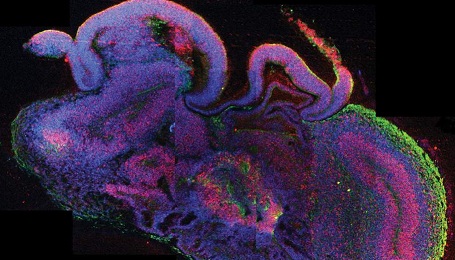It looks like you're using an Ad Blocker.
Please white-list or disable AboveTopSecret.com in your ad-blocking tool.
Thank you.
Some features of ATS will be disabled while you continue to use an ad-blocker.
share:
Stem cell scientists have grown a miniaturised "brain-in-a-bottle" which they hope will lead to treatments for neurological and mental diseases.

It's amazing what they can grow these days in laboratories, ears on rats, livers, eyes and now brains. I am all for it if it helps them one day find cures for things like autism and schizophrenia.
Here's the link for more info.

The tiny hollow "organoids", measuring three to four millimetres across, have a structure similar to that of an immature human brain including defined regions. But the scientists insist they are still a long way from building a working artificial brain - or even replacement parts for damaged brains.
The goal was to produce a biological tool that can be used to investigate the workings of the brain, better understand brain diseases and test out new drugs. One expert said the "audacious" discovery could lead to the future creation of a simple animal-like brain that could be linked to sense organs and had the ability to learn.
Other laboratory "models" of human organs have previously been grown from stem cells, including those replicating the liver, intestine, pituitary gland and eye.
The key to the new research involved nourishing immature cells in a gel-like "matrix" that allowed the complex organoid structures to develop. These were then transferred to a spinning bioreactor which provided extra nutrients and oxygen, enabling them to grow much larger in size. After two months of development the "mini-brains" had become globular spheres up to four millimetres in diameter. Each one mimicked the layered structure of a human brain growing within a developing foetus.
Among the identifiable regions were a cerebral cortex, forebrain, choroid plexus - the body that produces cerebro-spinal fluid - and even a rudimentary retina.
It's amazing what they can grow these days in laboratories, ears on rats, livers, eyes and now brains. I am all for it if it helps them one day find cures for things like autism and schizophrenia.
Here's the link for more info.
Its not that amazing.
It was predicted in the film and book " Frankenstein"
It was predicted in the film and book " Frankenstein"
Wonder how long it will be before they grow something like that specifically for computing...
Steve Martin ........ paging Mr Martin..
www.imdb.com...
Seriously, it does seem rather a scary prospect..all in the name of science and research..
PDUK
www.imdb.com...
Seriously, it does seem rather a scary prospect..all in the name of science and research..
PDUK
reply to post by Lady_Tuatha
Maybe we can swap out our current leaders brains and
give them a new one? Cant hurt to try!!
Maybe we can swap out our current leaders brains and
give them a new one? Cant hurt to try!!
reply to post by Lady_Tuatha
Well they are already working towards organic computers, and they say that the human brain is basically a computer, so yea....maybe one powered by your own brain? I wonder if you would be naturally linked with it like a twin or if it would be separate from you except through artificial interface?
Well they are already working towards organic computers, and they say that the human brain is basically a computer, so yea....maybe one powered by your own brain? I wonder if you would be naturally linked with it like a twin or if it would be separate from you except through artificial interface?
Originally posted by Thorneblood
Wonder how long it will be before they grow something like that specifically for computing...
Hell, I'm turning into the person that says "Star Trek predicted it!"
Bio-neural Gel Packs
The gel packs formed the basis of the bio-neural circuitry, which was essentially an organic computer system. The packs contained neural fibers surrounded in a blue gel with metallic interfaces on the top and bottom. They helped store more information and operated at faster speeds than isolinear circuitry.
The fibers in an individual gel pack were capable of making billions of connections, thus generating an incredibly sophisticated and responsive computing architecture. This kind of organic circuitry allowed computers to "think" in very similar ways to living organisms; by using "fuzzy logic", they could effectively operate by making a "best guess" answer to complex questions rather than working through all possible calculations. This was due in part to the inherent ability of organic neural systems to correlate chaotic patterns that eluded the capacities of conventional hardware.
Bio-neural Circuitry
Bio-neural circuitry is a technology incorporated in bio-neural gel packs. It was incorporated into Federation Starship USS Voyager around 2371. Much of the usual isolinear circuitry was replaced with bio-neural cells, which can process information more efficiently, and hence speed up computer response time. The Intrepid-class was the first equipped with bio-neural systems.
So this brain-in-a-jar makes me wonder....how long until we have computers like this??
edit on 8/28/2013 by Nyiah because: (no reason
given)
reply to post by Nyiah
Yeah but I'm just worried that when I get my first bio computer its going to die because I gave it the flu.
Can we get flu vaccines for our bio computers?
Yeah but I'm just worried that when I get my first bio computer its going to die because I gave it the flu.
Can we get flu vaccines for our bio computers?
reply to post by Openeye
I would be more worried about our operating system having an open back door that anyone can just penetrate as they like
I would be more worried about our operating system having an open back door that anyone can just penetrate as they like
edit on 28-8-2013 by
Thorneblood because: (no reason given)
reply to post by Lady_Tuatha
Lady_Tuatha you beat me to the punch!!!! Fast one, she is!!!!!
I don't think people realize just how significant and scary this is. We are actually watching the Birth of skynet as we speak. Drones, Robots, Computer systems, all ran by human-brains in petri dishes all networked together.
It's coming regardless. Another ATS member argued with me for 5+ pages that this won't happen, and yet look, the evidence keeps popping up.
Wonder how long it'll take to figure out consciousness and how to transfer it from old brain to new brain. I say 15-20 years tops!!!!
Lady_Tuatha you beat me to the punch!!!! Fast one, she is!!!!!
I don't think people realize just how significant and scary this is. We are actually watching the Birth of skynet as we speak. Drones, Robots, Computer systems, all ran by human-brains in petri dishes all networked together.
It's coming regardless. Another ATS member argued with me for 5+ pages that this won't happen, and yet look, the evidence keeps popping up.
Wonder how long it'll take to figure out consciousness and how to transfer it from old brain to new brain. I say 15-20 years tops!!!!
reply to post by dominicus
That is actually a scary thought!

There is still a hell of a lot they dont know about the human brain, methinks they should be very careful until they are sure they know what they are messing with.
can you imagine a lab grown brain put in to this guy -
That is actually a scary thought!

There is still a hell of a lot they dont know about the human brain, methinks they should be very careful until they are sure they know what they are messing with.
can you imagine a lab grown brain put in to this guy -
I'm going to direct people who read my comment to this movie scene, 2:25 , as I did in another thread:
www.youtube.com...
I can give a page, write a book actually, of examples of side effects by certain developments. Some examples: children raised in highly sterile environments are believed to develop auto immume diseases. Gonorrhea has become immume to antibiotics. Smart phones causing back problems. Medicine residue and phytoestrogens making sperm less fertile. Etc.
I do love it though. Because slowly the world is going back to zero and becomes my own twisted paradise.
www.youtube.com...
I can give a page, write a book actually, of examples of side effects by certain developments. Some examples: children raised in highly sterile environments are believed to develop auto immume diseases. Gonorrhea has become immume to antibiotics. Smart phones causing back problems. Medicine residue and phytoestrogens making sperm less fertile. Etc.
I do love it though. Because slowly the world is going back to zero and becomes my own twisted paradise.
reply to post by Lady_Tuatha
Thanks for the picture of the "Terminator". I never realized that he had Ivory bone like human teeth. Kind of odd for a metal (115) robot which never has to eat.
Thanks for the picture of the "Terminator". I never realized that he had Ivory bone like human teeth. Kind of odd for a metal (115) robot which never has to eat.
To truly probe consciousness, this is the kind of research that is needed.
Very interesting stuff to think about as i drift off to sleep tonight.
Very interesting stuff to think about as i drift off to sleep tonight.
One expert said the "audacious" discovery could lead to the future creation of a simple animal-like brain that could be linked to sense organs and had the ability to learn.
That is rather disturbing when it is said like that.....couldn't he have just said "Hey maybe one day we will make you a pokemon, that would be cool right?"
I hope mine shoots lasers, or has an emp blasting roar attack. There is gonna be some awesome cyborg battles in the future.
edit on 29-8-2013
by Thorneblood because: (no reason given)
new topics
-
Watch as a 12 million years old Crab Emerges from a Rock
Ancient & Lost Civilizations: 4 hours ago -
ILLUMINATION: Dimensions / Degrees – Da Vincis Last Supper And The Philosophers Stone
Secret Societies: 10 hours ago -
Just Sick of It! Done! Can't take it anymore!
General Chit Chat: 11 hours ago
top topics
-
Speaking of Pandemics
General Conspiracies: 13 hours ago, 9 flags -
ILLUMINATION: Dimensions / Degrees – Da Vincis Last Supper And The Philosophers Stone
Secret Societies: 10 hours ago, 9 flags -
Watch as a 12 million years old Crab Emerges from a Rock
Ancient & Lost Civilizations: 4 hours ago, 9 flags -
Just Sick of It! Done! Can't take it anymore!
General Chit Chat: 11 hours ago, 8 flags -
Stuck Farmer And His Queue Jumping Spawn
Rant: 13 hours ago, 4 flags
active topics
-
Winter Storm
Fragile Earth • 31 • : NorthOS -
Just Sick of It! Done! Can't take it anymore!
General Chit Chat • 12 • : DontTreadOnMe -
What Is 'Quad Demic'? Mask Mandate Returns In These US States
Diseases and Pandemics • 37 • : BeyondKnowledge3 -
Musk calls on King Charles III to dissolve Parliament over Oldham sex grooming gangs
Mainstream News • 175 • : UpIsNowDown2 -
Joe Biden gives the USA's Highest Civilian Honor Award to Hillary Clinton and George Soros.
US Political Madness • 40 • : marg6043 -
Vehicle Strikes people in New Orleans
Mainstream News • 300 • : Oldcarpy2 -
DONALD J. TRUMP - TIME's Most Extraordinary Person of the Year 2024.
Mainstream News • 61 • : Oldcarpy2 -
Candidate Harris Supporter MARK CUBAN Says Trump Has No Smart-Intelligent Women in His Orbit.
2024 Elections • 88 • : Oldcarpy2 -
Matthew Livelsberger said he was being followed by FBI
Political Conspiracies • 72 • : WeMustCare -
Watch as a 12 million years old Crab Emerges from a Rock
Ancient & Lost Civilizations • 9 • : FullHeathen
